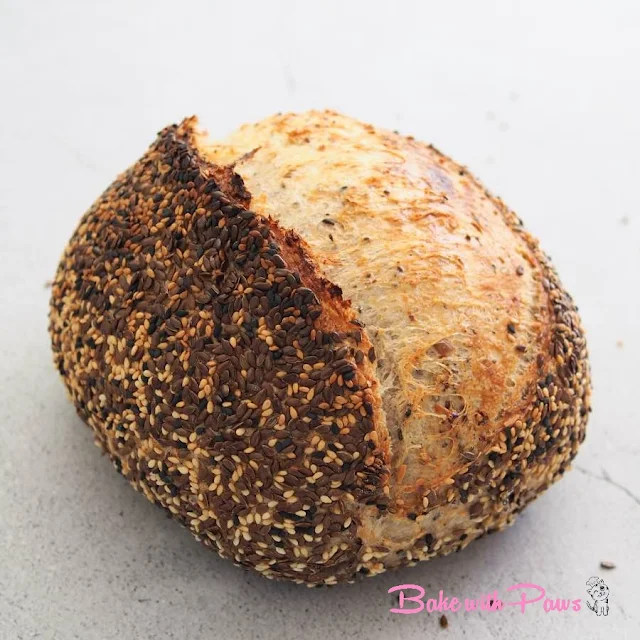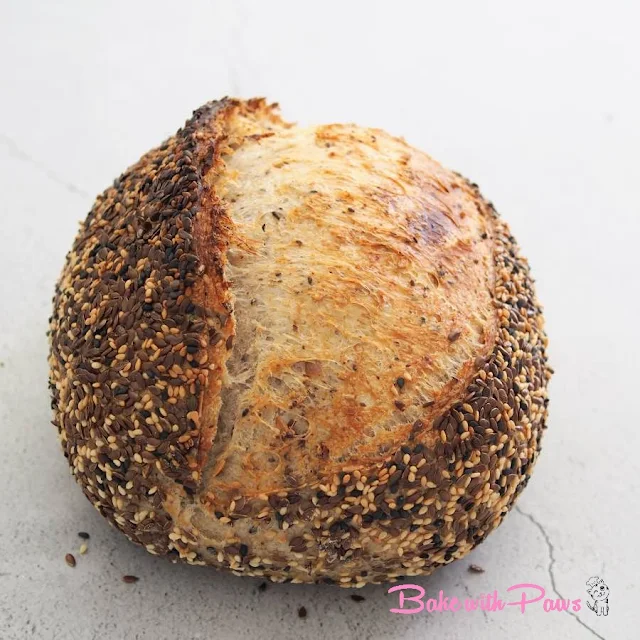Breads (Sourdough) - Open Crumb
Multiseed Open Crumb Sourdough Bread
August 04, 2019
| Recipe by Bake with Paws
Scroll to the bottom of the page for "PRINT RECIPE" ⬇
Characteristic of this bread: The texture is moist with a hard crust. Usually sourdough starter provides an aromatic flavour to the bread and with addition of roasted seed, the bread has a more substantial flavour.
If you have any questions regarding this recipe or any other post, please leave me a comment in the “LEAVE A COMMENT” link and I will reply you as soon as possible. Do tag me on Instagram @Bakewithpaws if you attempt on this recipe.
How To Make Multiseed Open Crumb Sourdough Bread
INGREDIENTS:
270g bread flour (I used Japan high gluten flour - About 12% protein) - 90%
30 whole wheat flour - 10%
60g active sourdough starter or levain (100% hydration) -20%
230g - 240g water - 78% - 82% final hydration (I used 240g)
6g salt - 2%
40g multiseed, toasted (black and white sesame seeds, pumpkin seed and flaxseed)
Coating: black and white sesame seeds and flaxseed, raw
- Please refresh your starter several times before baking day in order to get a better result if you do not feed your starter daily or regularly.
- Please reserve some liquid and not add it all in one go as each flour absorbs water and hydrates differently.
Ambient temperature after adding in levain - 26C - 27C
Total Bulk Fermentation - 5 hours and 30 minutes
METHOD:
- Feeding starter
- Feed ratio of 1:1:1, keep at room temperature (28C – 30C) and wait until tripled, around 4 – 5 hours.
- Please feed your starter at the ratio that fit your schedule as long as the starter is at its peak when use. Please click here for here "Sourdough Starter Recipe"
- Multiseed
- Coarsely blend the toasted pumpkin seed and flaxseed in a chopper machine. Then add in the toasted sesame seeds together.
- Mixing the dough
- Dissolve levain and water in a bowl of stand mixer. Add in flours and salt. Mix with paddle attachment for about 3 - 4 minutes at speed 2 (KA mixer) and slowly turn to speed 4 or until the dough turns smooth, comes together and away from the sides of the bowl.
- Cover and rest for 30 minutes at room temperature around 26C - 27C.
- Lamination & Spreading the seeds
- Lightly mist the counter top with water and wet your hand.
- Pull from centre out to form a rectangle shape.
- Sprinkle the toasted multiseed evenly.
- Pick up one edge and fold into the center.
- Pick up other edge and fold into the center over first section.
- Fold the top down half way. Fold the bottom up.
- Put dough in a new dish (square pyrex dish) that greased with a little oil. The reason to use a square dish is because it is easier to judge how much the dough has spread. Cover and rest for about 40 - 45 minutes or until the dough spreads.
- Coil Folds
- Coil Fold 1 - At this stage, the dough is weak and extensible. Fold the dough in the dish. Cover and rest for about 30 - 45 minutes or until dough spreads.
- Coil Fold 2 - At this stage the dough still extensible but stronger compare with the dough before the 1st coil fold. Fold the dough in the dish. Cover and rest for about 45 - 60 minutes or until dough spreads.
- Coil Fold 3 - The dough did not spread as much as before and not so extensible if compare with previous fold. So, I decided it will be the last coil fold. However, if the dough is still quite extensible and spread a lot, then you will need one or two more coil folds. Fold the dough in the dish. Cover and rest for 60 - 90 minutes or until dough rise 50 - 60% in size since you added the levain.
- Shaping
- About 90 minutes later, the dough had risen about 50% - 60% in size since adding the levain. The dough should look puffy. It should jiggling when you slightly shake it. This is the end of bulk fermentation. The total fermentation time was 5 hours and 30 minutes for this bread.
- Flour the counter top. Shape and transfer to a flour proofing basket. Please watch video here for shaping.
- Brush the top of the dough with plain water and roll the dough (top) into a dish filled with sesame seeds and flaxseed then transfer to a banneton with the seam side up.
- Proofing On The Counter
- Let it proof in the proofing basket room temperature for 15 minutes (27C - 28C ambient temperature)
- Cold Retard
- Then retard overnight in the fridge (4C) for 12 - 16 hours. This bread was about 15 hours.
- Baking -
- Preheat oven with the dutch oven (cast iron) at 250C (top & bottom heat) for about 45 - 60 minutes before baking.
- Take bread dough out from the fridge, invert onto a parchment paper. Using a razor blade attached to a lame slash the dough approximately 0.5 inches deep at 45-degree angle. Immediately transfer the dough with the parchment paper to your preheated dutch oven.
- Bake with cover on for 25 minutes. Remove the cover and lower the temperature to 220C (top & bottom heat), continue bake for another 10 minutes.
- Remove bread from oven and dutch oven. Let it cool on rack completely before slicing.
GENERAL NOTES
SOURDOUGH STARTER
Please click this link for "How To Make Sourdough Starter" and "Sourdough Maintenance"
A healthy starter is very crucial as advised by Baking with Gina. It is advisable to feed your starter regularly if you want your bread to rise nicely and to use the starter (levain) at its peak. A starter that is fed regularly will be more active in general. If the mother starter is not strong, the bread dough will not rise a lot even though the starter is used at its peak.
HYDRATION
The liquid measurement given is also a guide. It is advisable to always reserve some liquid and not add it all in one go. This would give you the opportunity to adjust if necessary. If dough is too dry, add the reserve liquid one tablespoon at a time until the right consistency. This is because each flour absorbs water and hydrates differently.
BULK FERMENTATION
Bulk fermentation starts when you add in levain to the dough and ends when the dough is ready for shaping.
TEMPERATURE DURING BULK FERMENTATION
Ambient temperature plays a very important part in sourdough baking. It will affect the dough temperature and eventually affect your fermentation time. The cooler ambient temperature will extend the fermentation time. The greater degree of proof, the stronger the dough will be as explained by Trevor J. Wilson.
The ambient temperature that worked for me is between 25C - 26C and bulk fermentation time is between 4.5 hours to 5.5 hours. At the end of bulk fermentation, my dough would have increased 50% in volume. The dough should look puffy. It should jiggling when you slightly shake it. This is the end of bulk fermentation.
But, my kitchen ambient temperature (without air-conditioner) was 29C - 30C. So, I have to bring down the temperature.
How to bring down ambient temperature?
- Air-conditioner room - Rest the dough in air-conditioner room during bulk fermentation. I used this option sometimes. I turned on my air-conditioner when I added in levain and try to maintain temperature between 25C - 26C.
- Home oven (that's turned off) - Place ice cooler packs inside along with an ambient temperature thermometer. Then place your dough during bulk fermentation in the oven. Keep an eye on that thermometer and try to keep between 25C - 26C.
DOUGH STRENGTH AND EXTENSIBILITY
Too strong (tension or elastic) dough will take a longer time to increase (proof) in volume. So too strong dough may not have good oven spring and open crumb. While too weak dough (extensibility) dough may not hold it shape and rise with good oven spring too.
So over-working the dough (too strong dough) or under-working (weak dough) may affect the crumb structure and oven spring.
The number of coil folds is not fixed and very much depends on the strength and extensibility of the dough.
As demonstrated in an experiment by Kristen (Full Proof Baking) the over-worked dough rose super tall but was smaller in overall size and had a more dense crumb while the control dough rose tall during the oven spring and had a better overall result.
How do we know when it is enough and no more coil folds are needed?
We usually do 3 coil folds for this method. However, if by the second coil fold the dough is strong with less extensibility as you lift up a part of the dough then it should be the last coil fold, or just do a half coil folds instead of full. The resistance of the dough to being folded should be an indication to refrain from folding further.
How do we know when to do the next coil fold or stretch & fold?
When the dough spreads. Please do not rely on the time given in the recipe as it is just a guideline. Please watch your dough and not the clock.
SALT
You may wonder why most of the recipes asked to add salt after autolyze and adding levain. Salt will tighten the gluten and make it harder to stretch.
Labels:
Breads (Sourdough) - Open Crumb,







Why does your website now has many ads? S😩D
ReplyDeleteHi, Which stage are the multi seeds added in?
ReplyDeleteThanks
Hi, thanks for reading. I added the seeds during lamination. Please refer to Step 6 Lamination.
DeleteCheers :)
Possible to create a printable version of all your recipes? So don't have to print the ads.
ReplyDeleteHi, thanks for reading this recipe. I have tried to install printable button in my website. Unfortunately it didn't work. I am so sorry. I can understand the inconveniences caused.
DeleteCheers :)
Hi! I've tried this recipe in an Aircon room of 25C, and my 3 coil folds were after 30mins each. However, throughout the BF, the dough still seemed extensible (a little stronger at 3rd CF compared to 1st) but when I tried to shape after BF, the dough splat flat and could not hold any shape. May I know what went wrong? Thank you! My starter is active and could triple in 3hours. Thank you!
ReplyDeleteHi, thanks for trying this recipe. The number of coil folds is not fixed and very much depends on the strength and extensibility of the dough. It could be because of the flour. Some flour is more extensible. In this case, please add one or two more coil folds.
DeleteI hope it helps.
Cheers :)
Hi, it was written levain as 60g sourdough starter under the ingredients but under no. 3 in method, you mentioned 65g of levain. Which is which? I would like to make this bread but I was not sure about the amount of levain. Please clarify and thanks.
ReplyDeleteHi, Sorry for the typo error. It should be 60g levain/active starter. I have already amended.
DeleteThanks for dropping by.
Cheers :)
Hi!, would like to understand more on - refresh your starter "serval time" before baking day. Is it to discard and feed the starter again and again before baking day.
ReplyDeleteHi, thank you for visiting Bake with Paws. Yes, you are right. You may want to see the reference here. However, please adjust accordingly to your schedule and your stater.
DeleteCheers :)